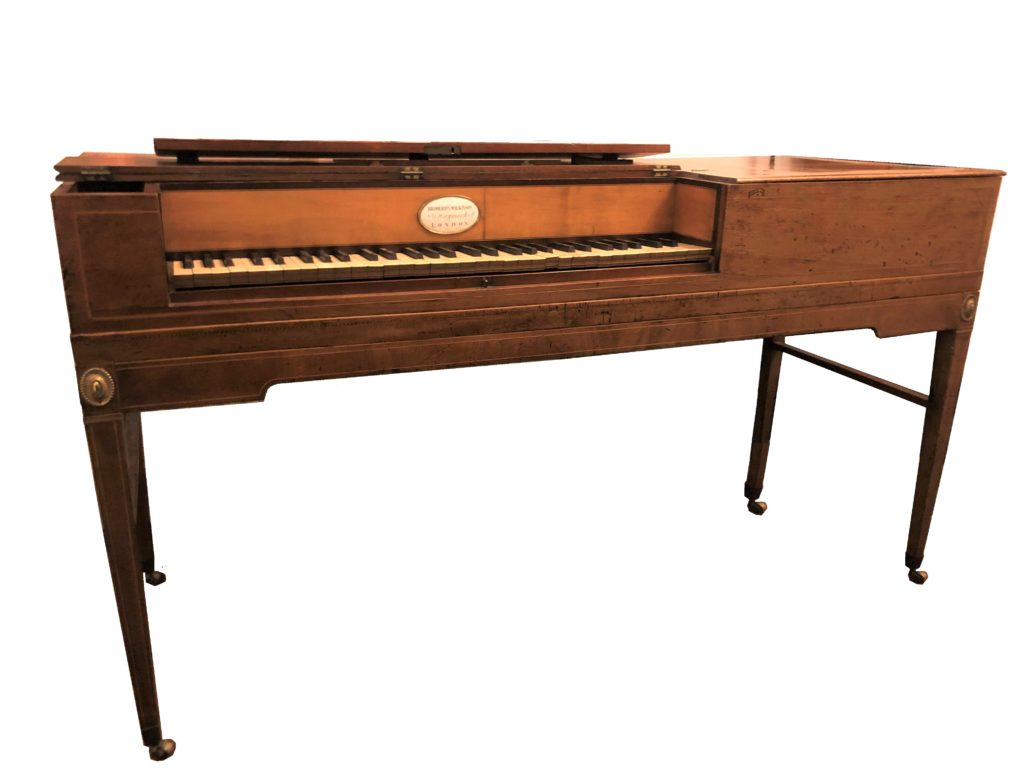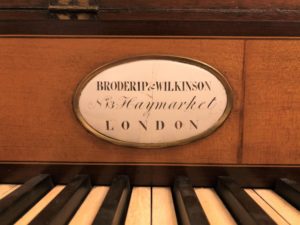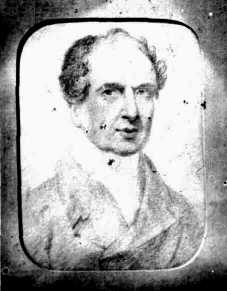Broderip & Wilkinson 1798
Description

| Date: | 1798 |
| Origin: | London |
| Serialnumber: | 450 stamped, Nameboard: 54 |
This square piano is a late testimony from the era of the Longman & Broderip company. After their bankruptcy and the split of the two former business owners in 1795, the branch of the firm Broderip & Wilkinson was founded. This instrument was sold in the early years by the two new business partners.
This square piano is similar in almost every detail to instruments from the late period of the Longman & Broderip company. The case is made of mahogany with surrounding, multi-coloured inlays made of different woods and rests on a French stand with brass castors. On each side around the stand are brass applications that cover the screws of the frame. The keys are covered with ivory and ebony. Interesting is that the ivory coverings are of less quality than those from instruments of the earlier production period under Longman & Broderip. It can be assumed that the supplier for the ivory changed and / or that Broderip & Wilkinson purchased cheaper materials in order to reduce costs. It is proved that Longman & Broderip had their instruments built by different well-known instrument makers and then provided them with their label. Broderip & Wilkinson continued this practice. This leads to the question of whether the company was now supplying their instrument makers with components in order to reduce the costs? Further research on this is currently ongoing.
There are two stops for dampers and lute and the piano is double strung. The stamped serial number 450 is located on the left inner side near the hand levers. The nameboard is also stamped with the number 54 and is decorated with an oval cartouche made of enamel. It bears the inscription:
“Broderip & Wilkinson
No. 13 Haymarket
London”

Tafelklavier Broderip & Wilkinson, London 1798 – Eric Feller Collection (Nameboard)
The square piano has a single action with leather-covered hammers, single dampers and has a compass of 5 octaves (FF – f3). The original dust cover, which is covered with dark green silk, is preserved.
At the time of purchase, it was in absolute original condition and was never been revised or restored before. By examining the piano, a one penny coin from 1863 was found under the keyboard.
For more information about Longman & Broderip, click here.
George Wilkinson was born on November 5, 1785. After entering into a business relationship with Francis Broderip, his eldest brother Charles Wilkinson joined the company in 1805. After the death of Francis Broderip in 1807 he produced instruments under the name Wilkinson & Co. On September 23 1809, he married Elizabeth Cecilia Mary Broadhurst. The marriage was announced in the “Gentleman’s Magazine” of 1809. Together they had 7 children (Ann (1814 – 1814), Emma (1815 – 1889), Matilda (1817 – 1876), Oriana (1818 – 1853), Louisa (1820 – ?), Alfred Broadhurst Wilkinson (1822 – 1854), and Henry Broadhurst Wilkinson (1824 – ?).
In 1809, Wilkinson commissioned Augustus Leukfeld and George Astor to produce licensed pianos under William Southwell’s patent (EN 3029, 1807). In 1810 he sold the publishing business to Thomas Preston (1789 – 1834) and entered into a new business relationship with Robert Wornum (1780 – 1852), having borrowed £ 12,000 from his father. The Wilkinson & Wornum company now produced improved upright pianos and the factory and showrooms were located near Hanover Square at 315 Oxford Street and 11 Princes Street. The warehouse and factory were destroyed by fire in 1812, with up to 70 workers were laid off and debts over 16.500 pounds were left. In 1813 the partnership broke up and the company was transferred to Wilkinson’s father, who paid the debts.
Towards the end of 1813 Wilkinson rented a house on Howland Street No. 32 and founded a piano factory in Oxford Street No.315. In 1816 he added showrooms on New Bond Street. Instruments from this period were highly commended by Pleyel.
Together with Ferdinand Hirschfeld, he entered into a new partnership after 1830. Both produced special patented candles. However, this partnership also ended in bankruptcy in 1835.
In 1854, George Wilkinson left London and went to Milford Haven to escape the cholera in London. There he died in 1855 from a stroke.

Portrait of George Wilkinson, in pencil, by Haughton, 1847
Other surviving instruments by Broderip & Wilkinson:
- 1798 – 1807 square piano – Musikhistorisk Museum & Carl Claudius’ Samling, Copenhagen Denmark
- 1798 – 1807 square piano – Geoff Watson, Barnard Castle, England
| Length: | 155 cm |
| Width: | 56 cm |
| Height: | 22 cm |
| Circumference: | 5 octaves (FF - f3) |
| Mechanics: | Single Action |
| Pedals: | 2 stops: dampers & lute |
| Signature: |
"Broderip & Wilkinson No. 13 Haymarket London" |

